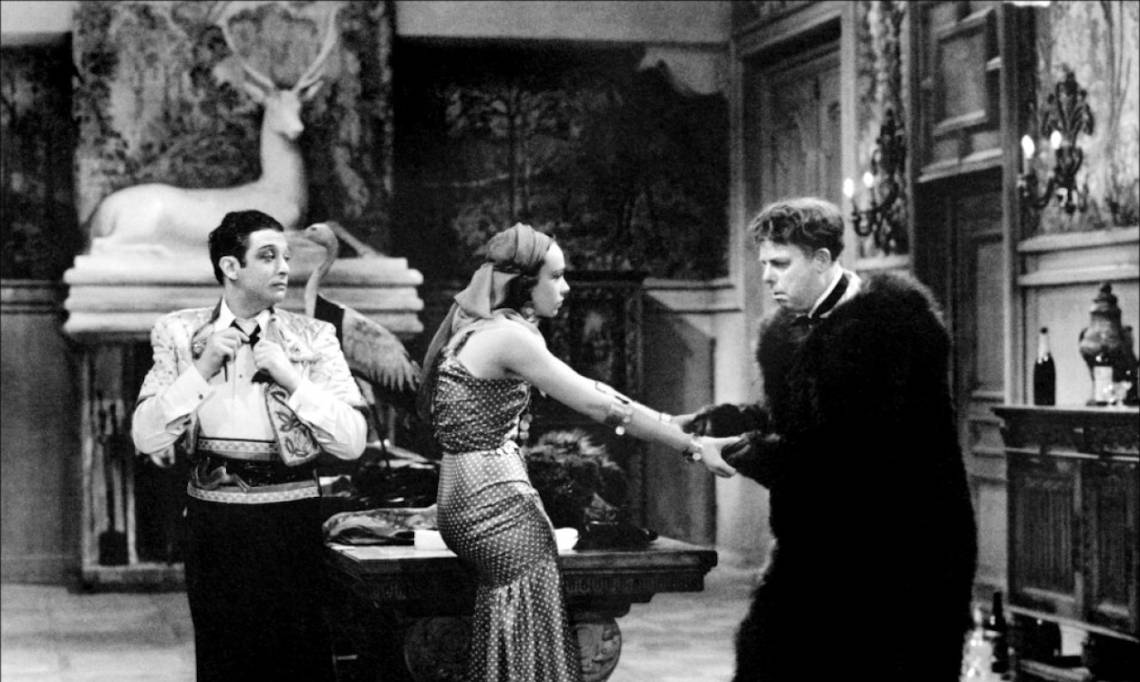Jean Renoir — the director of this film — was the son of the famous painter by the name of Pierre — Auguste Renoir, who was one of the foremost artists of the Impressionist movement. Impressionism was characterized by thin & subtle yet vivid & powerful brush strokes, as well as an emphasis on ordinary subject matter. Some of Pierre’s most celebrated works, housed in such esteemed locations as the Musée d’Orsay, are of scenes featuring the elegant, well-to-do, upper crust, “people of note”, if you will, going about their extravagant affairs — dining on boats, dancing in elaborate, organdy outfits underneath pearly white chandeliers suspended from...well, to be honest with you, I am actually not quite sure what the chandeliers in this particular painting (see below) could be hanging from since the scene appears to be taking place outside. Perhaps they are being hoisted upright by private jets in the sky that have been commissioned to perform exactly that role for exactly this occasion — like caterers essentially.

Like I said, I am not quite sure.
Anyhoo.
It seems as if the apple did not fall all that much further from the proverbial tree, but it also seems as if it is of a different variety than was expected to blossom from such a tree.
By this, I do not mean that one was a painter while the other was a filmmaker. After all, both are expressive forms of art; both aim to, at least, elicit a response of some sort and, at most, inspire a thirst for revolution in the hearts, minds, and pelvic regions of those who happen to come into contact with it. Ditto for music, ditto for literature, ditto for dancing, hell, ditto for cooking. In this respect, the two Renoirs are quite similar as far as their chosen means of conducting themselves throughout the course of their tenure on this tumultuous little rock of ours.
Where they differ is in how they chose to reflect the society that they have been presented with - which, in turn, might suggest that there may have been a variance of values between the two. I do not mean to speculate, but I cannot help but think that, while the elder Renoir was stroking his canvas at those fancy dinner parties he always seemed to be able to paint with such ornate exquisity, fawning over the “respected” guests who had all gathered to engage in their decadent rituals, young Jean must have been huddled up in the corner somewhere, seething at the sight of such a slimy soiree of snakes.
This, at least, is the impression that I get from watching a film like this. Now, as I mentioned, the apple did not fall too far from the tree, and right from the title credits, you can certainly tell that Jean had picked up some of the papa bear Pierre’s old habits. Every artistic choice is undoubtedly intentional and done to instill within the viewer a rather inspective disposition, from the selection of an upbeat, major scale centred score to kick off a film about some real rotten, minor blues cats to the passage from the Pierre Beaumarchais’s Le Mariage de Figaro (The Marriage of Figaro) featured at the beginning, between the credits and the opening screen, which reads as follows (in English, so it might not rhyme, but I am not sure how many of you speak French so I am just going to go with the translation):
Sensitive hearts, faithful hearts
Who shun love whither it does range,
Cease to be so bitter:
Is it a crime to change?
If Cupid was given wings,
Was it not to flitter?
And love, of course, is no less a prominent subject of commentary throughout this film than anything else. To quote one of the gorgeous (and yet, on the inside, despicable) French girls, whose name I believe was Genevieve - alas, there were so many vapid, phony characters to keep track of and it was all shot in black and white, plus they all sort of looked alike, anyways, so forgive me if I am incorrect in this belief — who, herself, was quoting the writer Nicolas Chamfort, “love, as it exists in society, is merely the mingling of two whims and the contact of two skins.”
This is how it seems like all these rich folks look at love throughout the movie. I mean, here is this poor pilot - André - madly in love with this girl Christina, to the point where he flew a plane by himself across the Atlantic Ocean (no easy feat back in those earlier days of aviation) solely for the purpose of impressing her (as the Greeks have been saying since they used it to explain the Trojan War, “sto muni cerni karabi” — “pussy pulls ships” [thank my neighbor for that one]) and yet there she is out there, cavorting around with his so-called best friend, a heavy set dude named Octave. And meanwhile, while all this is going on, she is already married!
And they call these folks classy. They reveal themselves, throughout this film, to be nothing but trashy. The words they speak, the actions they take. Good lord, it fired me up just watching those snooters in action. Jean Renoir was coming out like Zach de la Rocha on this one.

